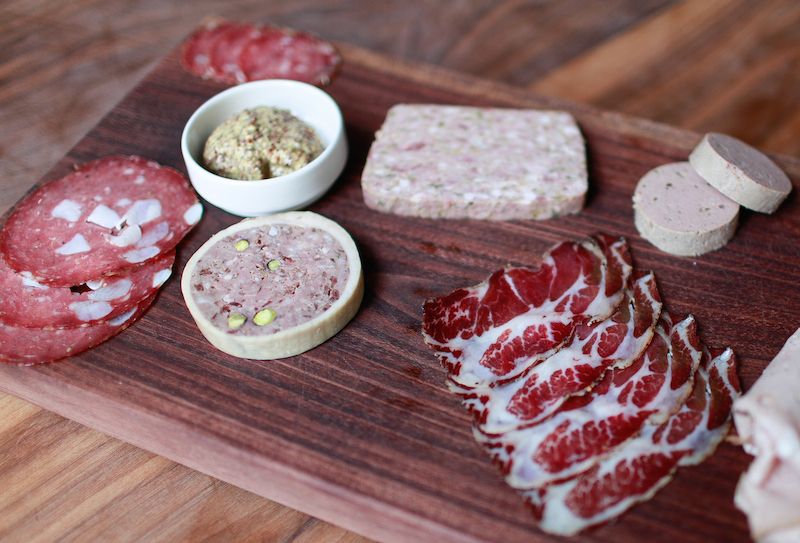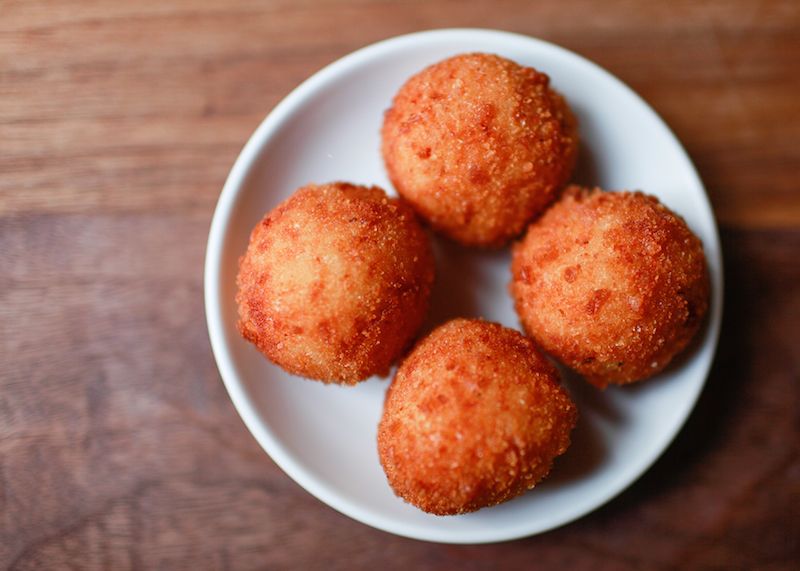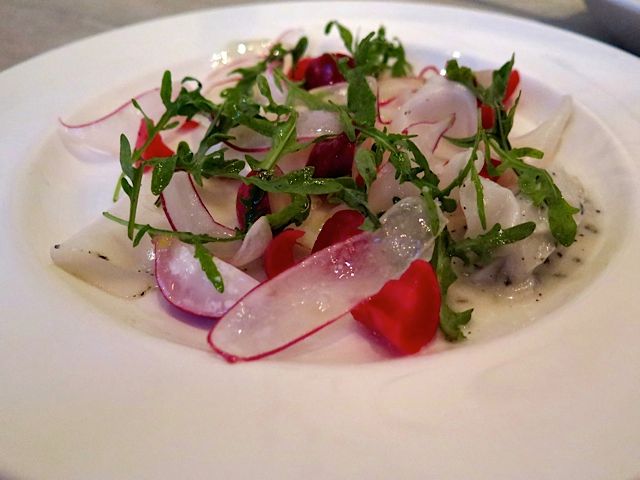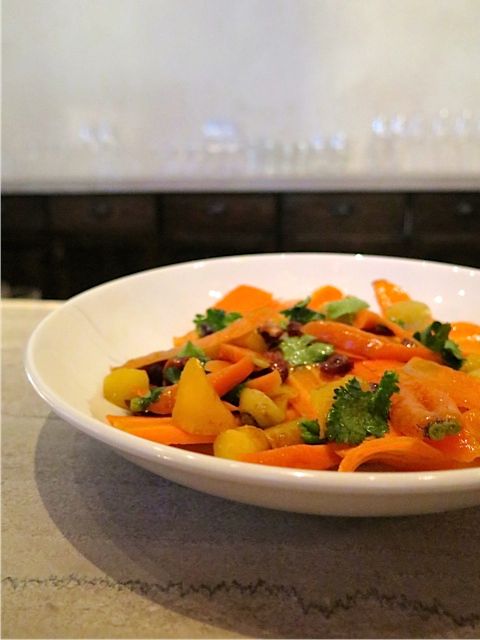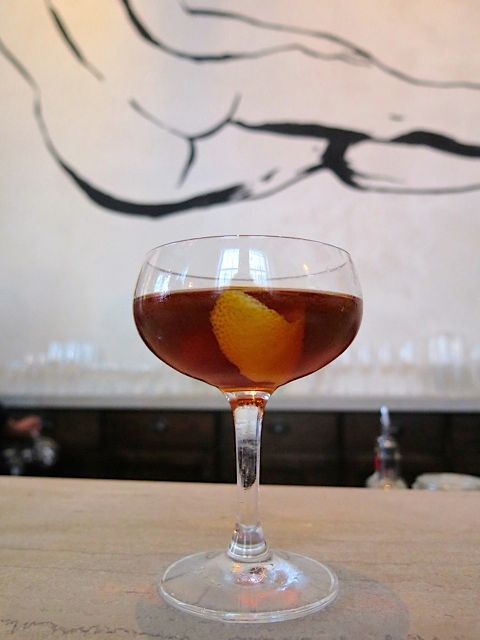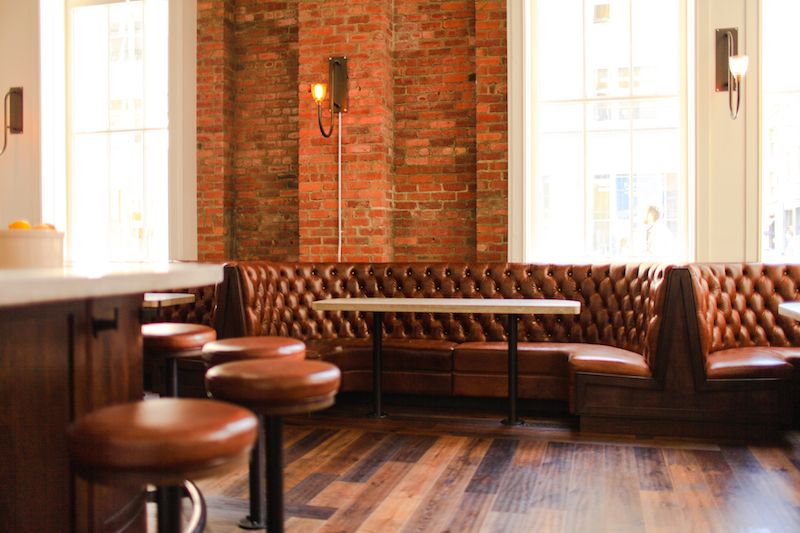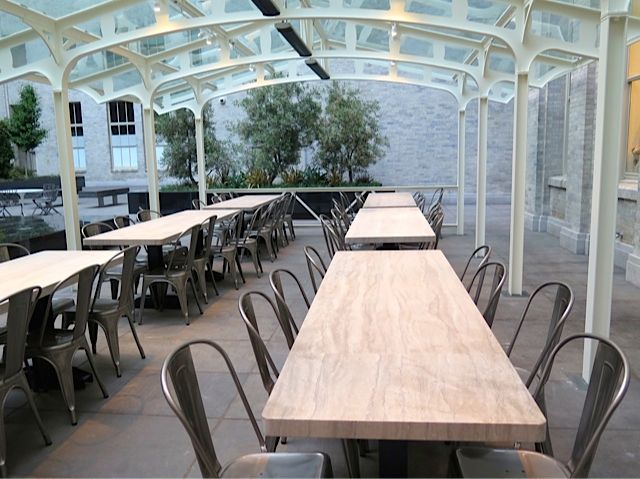Walking into TROU NORMAND—hopefully in the early evening so you can capture the soft light streaming through the enormous windows—you feel that slight shift in your brain, and soon your demeanor, as when you’re in a place of beauty and presence. I have always had a soft spot for this building (the 1925 Pacific Telephone building), San Francisco’s first significant skyscraper, and my introduction to the architect Timothy Pflueger and his Art Deco-influenced style when I moved to the city 20 years ago.
I so respect and appreciate how owner Thad Vogler (Bar Agricole) obviously cares a great deal about art, architecture, and aesthetics. For Trou Normand, he hired a New York team to curate and art direct the space (all the art is by women artists). Everyone murmurs about (and photographs) the enormous and now-iconic nude above the bar on the plastered wall by Ebecho Muslimova, in her languorous, “La Grande Odalisque”-like pose. She’s gorgeous.
Whether you manage to snag a coveted seat at the crowded marble bar, or you tuck into one of the precious oblong booths of tufted tobacco leather, hopefully you get a seat in the front room. The back room has a walnut communal table, but the cold Tolix stool-chairs are so uncomfortable, there’s nowhere to hang your purse, and it’s pretty lacking atmospherically (except for the cool concrete floor tiles by Concreteworks, and the peek into the kitchen).
However, there’s a pretty 48-seat patio out back that just opened. It’s under a glass canopy with heat lamps, and architect Boor Bridges is also installing some curtains to block the evening chill. Trou Normand is the kind of place you want to walk in to, and all the extra seating out back will help allow it. (Although if you have a group, you’ll definitely want to reserve one of the booths or back patio tables ahead of time.) And since the restaurant is open for breakfast and lunch during the week, the patio will be a sweet spot to enjoy your mortadella sandwich.
I’m gonna say it: I think chef Salvatore Cracco is doing some of if not the best salumi in town, and his charcuterie is also pretty stellar (he learned his craft at Adesso). His finocchiona ($6) and mortadella ($6)—always a tough one to nail—were seasoned by a deft hand and had such a pleasing, just-fatty-enough texture. It wasn’t until I took a bite of the silky, unctuous coppa ($7) that I realized a huge difference in play here: the meats were all served at a perfect temperature, and not too cold, which forces the fats to stiffen up (he’s using Mangalitsa pigs bred by Csarda Haz Ranch and Suisun Valley Farm for his salumi, and their sweet fat is something very special). The salumi have excellent moisture too—none were dry. Cracco also does some inventive salumi, like a captivating duck salami ($6) with blood orange and star anise, and an exotic dry merguez ($6) with lamb, chile, cumin, and cinnamon. There’s a rotating selection of about 14 in all—taste the rainbow.
The charcuterie section (10 items and counting!) has an herbaceous and rosy pink chicken salami cotto ($10) with chive, parsley, and tarragon, and the decadent tongue and cheek terrine ($6) is like a thick piece of stained glass piggy parts. Maybe it was the warm evening, but the little bowl of aspic we only took a bite of didn’t fare well for long—it melted quickly. The charcuterie section is an international meat fest: there are at least three kinds of pâté, and Italian selections like ciccioli, and German bierschinken, which may tempt you to order a Stiegl lager, farmhouse ale, or French cider as well.
You can try a chef’s selection ($19/$38), or go nuts like we did on our own and you’ll be served a huge wooden plank layered with your meats. My kind of heaven—walk the plank! A glass of the 2012 Niklas schiava ($9) is a fabulous salumi-friendly wine. Although I think the kitchen can do better than the epi bread they’re serving the meats with.
Interestingly, with all the kitchen’s charcuterie skills, the sausage plate ($20, featuring a fennel and basil sausage and a bratwurst) was completely underwhelming—the texture was off, and the salty meat felt dry and overworked. Another clunker was the bucatini all’amatricana ($14)—the pancetta-rich tomato sauce was fine, but the overdone bucatini nosed this dish into the penalty box.
For as much femininity there is on the walls, the menu is decidedly masculine. The meaty, simple mains are served à la carte, but the portions are hearty enough to share. There’s a roasted and grilled half chicken ($27) served with a juicy roulade of the thigh drizzled with a tasty jus—the chicken had a delicious kiss of the grill, although it we had to send it back for a bit more cooking time (pastured birds can be tricky that way). Because the kitchen is working with whole animals, one night we had thick slices of roasted pork leg ($14), and another night was all about the pork chop ($25), rubbed with fennel and cooked beautifully—it was enough for three people (even after you cut some of the excessive fat off). There’s a nightly fish option as well.
To round things out, get a side of the cheesy polenta ($6), and there are a variety of extremely simple vegetable sides, like grilled spring onions ($7), or peas with guanciale ($10). I liked the salads better—they featured a bit more attention, like different cuts and kinds of carrot ($9) with dried apricot, almond, orange, and parsley, or the lardo with thinly sliced radishes ($8) and arugula (please watch the salt on that one, kitchen crew).
The dessert section is a desert: you can get an affogato ($5), or a spendy slice of Mission Pie ($8). While I appreciate the restaurant supporting this local organization, the “slice” we had was like a sloppy cobbler on the plate, and five bites at that.
A better option is to drink your dessert. You’re in the capable hands of head bartender Eric Ochoa and his crew, who have quite the curated and extensive list of cocktails (most hail from “Cocktail” Bill Boothby’s 1891 American Bartender, who worked on New Montgomery street in the late 19th century). So salute the man with the Boothby (all mixed drinks, $11), with bourbon, sweet vermouth, curacao, and lightened up with some cava. You’ll also want some of their meaty arancini ($6, a total steal for four) to go with your drink, a swell bar snack. Something I really love is the simplicity of the back bar—all the bottles are out of sight and below the bar.
You’ll see guests sipping on little glasses of brandy, which is how the restaurant got its name: Vogler was on a buying trip in Normandy, and it’s a tradition to throw back a shot of Calvados in preparation for or during a big meal to make room (“a Norman hole”). The list of full of exclusive Armagnacs, Cognacs, and Calvados that the team has hand-selected from small-batch producers. Cheers to that.
This review was based on two dinner visits. The beguiling bar area and main room. Photo: The Light House.
